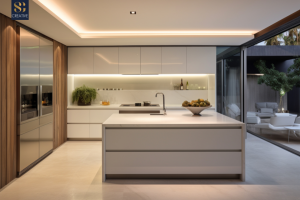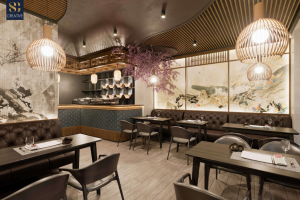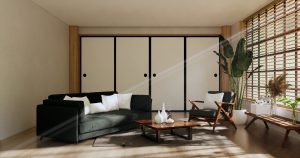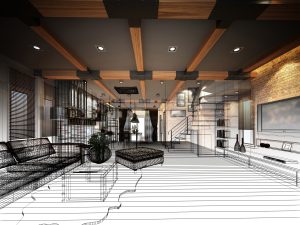When designing a restaurant, the selection of the right materials for the interior can significantly influence both the functionality and aesthetic appeal of the space. The materials you choose are integral to setting the right mood, enhancing the dining experience, and ensuring the space is durable and practical. Whether you are designing an upscale fine dining restaurant, a cozy café, or a casual eatery, understanding the advantages and challenges of each material type will help you make informed decisions. Here’s an in-depth comparison of five popular restaurant interior materials, each suited for different design needs and preferences:
1. Natural Stone – Elegant and Unique

A polished granite countertop with rich veins, complementing modern and rustic décor
Natural stone materials, such as granite, marble, and slate, are often favored for their elegance and timeless appeal, making them ideal choices for restaurant interior materials. Natural stone is frequently used in upscale restaurant designs, particularly for surfaces such as countertops, flooring, bar tops, and dining tables. The beauty and durability of stone make it an excellent option when you want to create a luxurious and lasting impression.
Pros:
- Durability: Natural stone is one of the most durable materials available. It can withstand heavy traffic and constant use in busy restaurant settings. Resistant to scratches, heat, and stains, it is particularly suited for high-traffic areas where durability is essential.
- Unique Aesthetic Appeal: Each piece of stone is unique due to its natural patterns and veining, which gives your restaurant interior materials a distinctive and high-end look. This uniqueness can add a touch of elegance and sophistication to your space.
- Longevity: Stone materials like granite and marble are built to last, making them a long-term investment for your restaurant. These restaurant interior materials can maintain their beauty for decades with the proper care and maintenance.
Cons:
- Weight and Installation: Natural stone is heavy, which can complicate both installation and future renovations. Moving or replacing stone surfaces, such as countertops or tabletops, requires extra effort and can increase labor costs.
- High Cost: Premium natural stone materials, especially marble, can be costly, both in terms of material and installation expenses. Restaurant interior materials can make stone an expensive option upfront, but its long-term durability can help justify the higher initial investment.
- Maintenance: Though natural stone is durable, it requires regular maintenance to keep it looking pristine. Surfaces like countertops and floors need to be resealed periodically to prevent staining and preserve their shine. While maintenance is minimal, neglecting it can lead to damage over time.
Natural stone can elevate your restaurant interior material choices with its durability, beauty, and timeless appeal, though it’s important to factor in the associated costs and maintenance to ensure it remains a worthwhile investment.
2. Wood – Timeless Tradition and Warmth

Cozy wooden tables and chairs made from oak, adding warmth and charm to the dining area.
Wood is a versatile restaurant interior material that has been a staple in restaurant designs for centuries, appreciated for its ability to blend seamlessly with various styles. From rustic country kitchens to sleek, modern dining rooms, wood adds warmth, charm, and a sense of comfort to any space. Its natural beauty, rich textures, and ability to age gracefully make it an enduring choice for restaurant interiors. Whether used in furniture, flooring, paneling, or accent features, wood has the unique ability to create an inviting atmosphere that makes diners feel at ease. Its versatility also allows it to be incorporated into a range of styles, from traditional to contemporary, making it a timeless material that suits any restaurant concept.
Pros:
- Warm and Inviting Aesthetic: Wood creates a natural, warm atmosphere that appeals to diners seeking a cozy and comfortable experience. It’s perfect for creating a welcoming environment that encourages guests to relax and enjoy their meals.
- Durability: Hardwoods such as oak, walnut, and maple are highly durable and can withstand the wear and tear that comes with high-traffic environments. When properly cared for, wood can last for many years.
- Versatility: Wood fits seamlessly into various design styles, from traditional to modern. Its timeless appeal makes it suitable for a wide range of restaurant interior material concepts, whether you’re designing a rustic farm-to-table space or a minimalist modern café.
- Aesthetic Customization: Wood can be stained or painted in various shades to complement your restaurant’s color palette and design theme, allowing for greater flexibility in achieving your desired look.
Cons:
- Vulnerability to Moisture: Wood is highly sensitive to moisture, which can lead to warping, swelling, or cracking if exposed to high humidity or spills. To preserve its integrity and appearance, restaurant interior materials must be regularly sealed and maintained. Proper care ensures that wood retains its natural beauty and functionality over time.
- Maintenance Needs: Wood requires consistent maintenance to keep it looking its best. Without proper care, wood can suffer from cracks, scratches, or infestations, particularly in high-moisture areas such as kitchens or bathrooms. Regular sealing, treatment for pests, and occasional refinishing are necessary to prevent damage and maintain the material’s charm.
- Higher Costs for Premium Woods: High-quality hardwoods, such as oak or walnut, can be expensive, especially when used for large-scale projects like flooring or custom furniture. Additionally, intricate woodwork may require more labor for installation, adding to the overall costs. While premium woods can elevate the aesthetic of your restaurant, they come at a higher price point.
Wood remains an iconic restaurant interior material, providing timeless appeal, versatility, and a sense of comfort that makes it a popular choice for any dining establishment. However, careful maintenance and consideration of costs are necessary to ensure it remains a valuable investment.
3. Plastic – Lightweight and Practical

Bright outdoor seating with colorful plastic chairs and tables, ideal for high-traffic spaces.
Plastic is a popular and practical choice for restaurant interiors, especially in fast-casual dining settings, outdoor seating areas, or high-traffic spaces where durability and ease of maintenance are essential. Its affordability and versatility make it an ideal option for restaurants that need to furnish large areas quickly and cost-effectively restaurant interior materials .
Plastic is commonly used in dining chairs, tables, and outdoor furniture due to its resistance to moisture, stains, and fading, making it perfect for both indoor and outdoor environments. Available in a wide range of colors, shapes, and finishes, plastic can be easily customized to fit various design themes, adding both functionality and style to the space without compromising on durability. Additionally, its lightweight nature makes it easy to rearrange or store, offering flexibility for restaurants that frequently change their seating arrangements.
Pros:
- Affordability:
Plastic is one of the most budget-friendly options for restaurant interiors. Its low cost makes it ideal for larger spaces or restaurants that need to furnish many areas at once without exceeding the budget. Plastic allows you to prioritize practicality while keeping costs down, making it perfect for fast-casual dining environments or budget-conscious restaurateurs.
- Lightweight and Flexible:
Plastic is incredibly lightweight, which makes it easy to move and rearrange. This restaurant interior materials is especially beneficial for restaurants that require flexible seating arrangements, or for outdoor spaces that need furniture that can be easily stored when not in use. Its portability offers convenience and adaptability for a variety of dining settings
- Low Maintenance:
Plastic is very easy to clean and requires minimal upkeep. Resistant to moisture, stains, and many of the elements that can damage other materials, plastic is ideal for high-traffic areas or outdoor patios. It can withstand frequent cleaning, making it a practical solution for restaurants that face a high volume of diners or outdoor elements.
Cons:
Lack of Elegance: While plastic is highly functional and affordable, it lacks the elegance and sophistication of materials like wood, stone, or metal. For upscale dining establishments, plastic may not create the luxurious, refined atmosphere that high-end restaurants aim for. Its utilitarian appearance may limit its appeal in more formal settings.
Less Durable: Though plastic is resistant to various environmental factors, it is not as durable as other materials such as wood or metal. Over time, plastic can crack, fade, or discolor, especially when exposed to heavy use or sunlight. While affordable, plastic does not have the long-term durability required for high-traffic restaurant environments.
Limited Aesthetic Appeal: Plastic can be molded into various shapes and sizes, but it lacks the natural textures and depth of materials like wood or stone. While it offers versatility in design, plastic may not provide the same visual richness or warmth. For restaurants aiming to create a stunning atmosphere, the lack of texture and refinement in plastic may not be ideal.
4. Glass – Sleek and Spacious

Sleek glass partitions and tables, creating an open, airy atmosphere.
Glass is a sleek and modern restaurant interior material that adds a sense of openness and luxury to your space. Whether used for windows, partitions, tables, or decorative accents, glass can make your restaurant feel more expansive and airy. It is ideal for contemporary, upscale restaurant interior designs that wish to highlight a clean and sophisticated look.
Pros:
- Creates a Sense of Space: Glass can make your restaurant interior material feel larger and brighter by enhancing natural light flow. Glass walls or partitions allow for an open, airy feel, which is especially beneficial for smaller spaces. The transparency and light-reflecting properties of glass help create a welcoming, spacious environment that draws guests in.
Modern and Elegant: Glass offers a sleek, clean, and modern aesthetic that adds an element of sophistication to any restaurant interior design. Whether used for windows, tables, or decorative accents, glass brings a luxurious and timeless appeal. It is particularly effective in upscale or contemporary restaurant interior material that aim for a polished, elegant look.
Easy Maintenance: Glass is relatively easy to clean and maintain, especially with the right cleaning products. Regular upkeep ensures that glass surfaces stay pristine and free from smudges, fingerprints, or dust. While glass may require more frequent cleaning than other materials, it can maintain a shiny, spotless appearance with minimal effort.
Cons:
- Fragility: Glass is prone to breakage, particularly if it is not tempered. This can pose safety concerns, especially in high-traffic or high-risk areas of the restaurant interior, such as around tables or kitchen counters. While tempered glass is stronger, it is still vulnerable to impact, and the risk of breakage can be a significant drawback.
- Maintenance: While glass surfaces are easy to clean, they tend to show fingerprints, smudges, and dust more easily than other restaurant interior materials. Keeping glass pristine requires frequent cleaning, which can be time-consuming and requires attention to detail to ensure a clear, spotless appearance.
- Cold and Impersonal Feel: Although glass can create a sense of openness and lightness, it can also feel cold or impersonal, particularly in dining areas. The sleek, hard surface may not foster the warm, inviting atmosphere that some restaurant interior designs desire. To balance the coolness of glass, consider incorporating soft elements such as cushions, rugs, or wood accents to create a more welcoming ambiance.
Glass remains a popular restaurant interior material due to its ability to enhance natural light, create a spacious atmosphere, and add an elegant, modern touch. However, its fragility, maintenance needs, and potential to feel cold should be carefully considered when incorporating it into your restaurant interior design.
4. Metal – Modern and Versatile

Modern dining with stainless steel furniture, adding a sleek, industrial touch.
Metal is increasingly popular in restaurant interior design, particularly for modern, industrial, and urban-style restaurants. Materials such as stainless steel, aluminum, and painted iron offer a sleek, contemporary look, adding an edgy yet refined aesthetic to any restaurant interior. These metals are not only visually striking but also incredibly durable, making them ideal for high-traffic areas that require sturdy furniture and decor.
Pros:
- Modern Appeal: Metal has a sleek, industrial look that works particularly well in contemporary and urban restaurant interior designs. It pairs seamlessly with minimalist, industrial, and eclectic design styles. The clean, polished finish of metal adds a modern touch that can elevate your restaurant interior material aesthetic and create a trendy, sophisticated atmosphere.
- Durability and Strength: One of metal’s key advantages is its remarkable durability. It is resistant to wear and tear, making it ideal for furniture, fixtures, and decor that undergo heavy use. Metal can maintain its strength and appearance over time, even in high-traffic areas, ensuring your restaurant interior material remains stylish without compromising on functionality.
Variety of Styles: Metal is available in a wide range of finishes, including matte, polished, or brushed, allowing you to match the material with your desired design concept. Whether you prefer a sleek, shiny look or a more subtle, muted finish, metal can be customized to complement any restaurant interior design theme, making it a versatile choice for various design aesthetics.
Cons:
Cold and Uncomfortable Feel: Metal furniture can feel cold and uncomfortable, especially without proper cushioning. In dining areas, this can detract from the overall comfort of your guests. To counteract this, you may need to add cushions or soft seating options, but this can add to costs and reduce the streamlined, industrial look that metal might otherwise bring to the restaurant interior.
Weight and Portability: Metal furniture tends to be heavier and less portable than alternatives like plastic or wood. If your restaurant interior material regularly rearranges seating or needs to adjust the layout, the weight of metal furniture can make this task more cumbersome and labor-intensive. The lack of portability can limit flexibility in creating a dynamic, ever-changing space.
- Risk of Corrosion: While stainless steel and other high-quality metals are durable, untreated or lower-quality metals can be susceptible to rust and corrosion, particularly in moist environments such as kitchens or bathrooms. Proper treatment and regular maintenance are essential to prevent deterioration, which can damage the material and affect its aesthetic appeal.
Metal remains a popular choice for restaurant interior materials, thanks to its durability, modern appeal, and versatility. However, its coldness, weight, and potential for corrosion should be carefully considered when choosing metal for your restaurant interior design.
Ready to Transform Your Restaurant’s Interior?
Choosing the right restaurant interior materials for your restaurant’s interior is one of the most important decisions you’ll make when designing a space that not only welcomes guests but also enhances their overall dining experience. The materials you select will play a crucial role in shaping the atmosphere, providing the necessary durability for high-traffic areas, and creating a sense of style that aligns with your restaurant’s brand and concept. Beyond aesthetics, the right materials can improve functionality, ease of maintenance, and the long-term sustainability of your restaurant’s interior.
When selecting restaurant interior materials, you need to consider how they will work together to create an ambiance that complements your cuisine, service style, and overall dining experience. Whether you’re aiming for an upscale, luxurious feel, a cozy, inviting atmosphere, or a sleek, modern space, the materials you choose will define the character of your restaurant interior. Durability is also a key consideration, as high-quality materials ensure longevity even in areas with heavy foot traffic. You want your restaurant to look great from day one and remain impressive over time, without needing constant repairs or replacements.
The right restaurant interior materials not only set the tone for your space but also contribute to its practicality, ensuring both guests and staff enjoy a seamless and memorable experience.
Transform Your Restaurant’s Interior with SG Corp: Where Beauty Meets Functionality
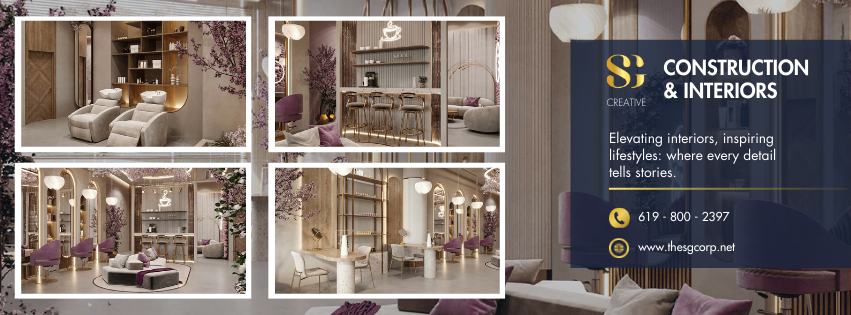
Our design process takes into account every detail
At SG Corp, we specialize in creating restaurant interiors that blend beauty, functionality, and durability. With years of experience in the industry, we understand the unique challenges of designing a space that accommodates both form and function. Our team offers tailored solutions that incorporate premium restaurant interior materials like stone, wood, metal, and glass, each chosen for its aesthetic appeal, practical benefits, and long-lasting performance.
Whether you prefer the timeless elegance of natural stone, the warm and inviting charm of wood, or the contemporary sophistication of metal and glass, we have the expertise to bring your vision to life.
Our design process takes into account every detail—whether it’s selecting the right restaurant interior materials, optimizing space planning, or ensuring a cohesive design that matches your brand identity. We understand that your restaurant is more than just a place to eat; it’s an experience. With SG Corp, you can rest assured that your restaurant interior material will not only look exceptional but will also function efficiently, offering both you and your customers a space that stands the test of time.
Let us help you create a memorable environment that draws in diners, enhances their experience, and elevates your restaurant interior material


